“White” and “colored” armor ... (part one)

The easiest way to finish gothic armor was to decorate strips of cut-through copper or brass with the edges of each piece. Such scalloped strips were fairly simple to manufacture, weighed a little, but gave the armor an elegant and elegant look.
That is why the knights didn’t need high mobility in the region of the neck and shoulder girdle, which is why, in the foreground, they had exactly security, not mobility. But in the East, where the bow all the time was the main weapons the rider, chain-lamellar armor and open-faced helmets continued to work for a very long time. Moreover, this weapon is very different from the new armor of soldiers of Western Europe.
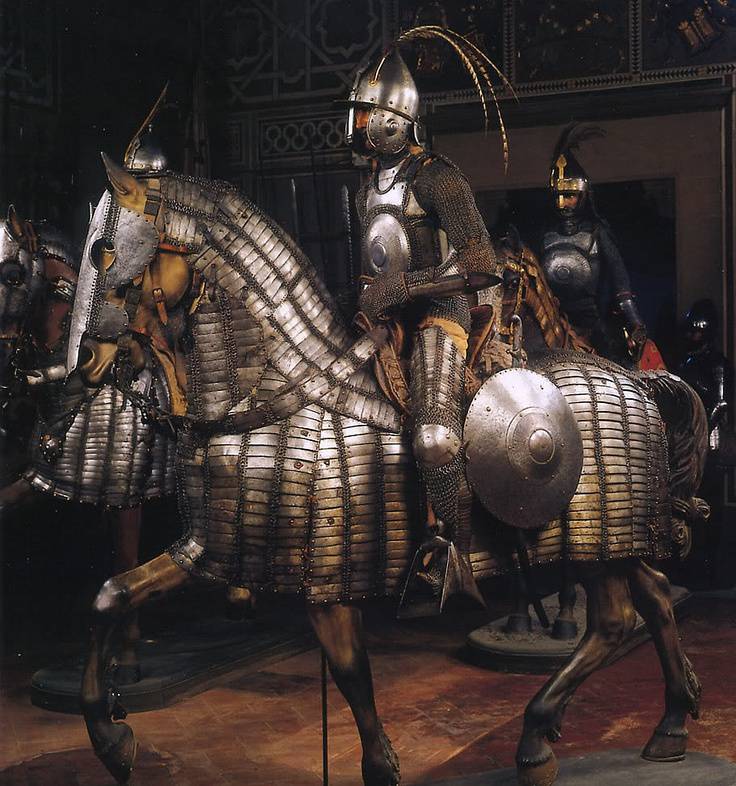
A 16th century Turkish rider's armor from the Topkapi Museum in Istanbul. As you can see, his armament differed from Western Europe only in that it gave him the opportunity to shoot a bow. It was convenient to decorate small plates by tapping.
K. Blair, a well-known British historian and gun expert, called the time from 1410 and by 1500 the year “a great period in stories knightly protective weapons ", because he believed that although the armor of the very high quality was made by the gunsmiths and later, nevertheless, they never again combined such high craftsmanship in their products with an understanding of the material with which they now mostly worked . Jewelry in the armor of this era played a minor role, and the master focused on perfecting their form, and as a result, people in this armor were justly called "steel sculptures". Later, on the contrary, the decoration passed any measure.
Well, it all started with the fact that the 11th century gunsmiths learned how to forge helmets from sheet metal. Prior to this, helmets were segmented, although in the East this technique has been skillfully used for many centuries. To do this, a sheet of iron of the desired thickness in the form of a disk was red-hot and was given a cup-shaped form with blows of a hammer, and only then it was treated completely with a hammer, chisel and files. Later, helmets began to be stamped altogether, which increased their durability, cheapened production and allowed for uniformity. Already in the 16th century, skullcap masters reached such a level of perfection that by the end of this century, or more precisely by the 1580 year, they could forge not only the parietal helmet, but the crest up to 12, from a single sheet of metal, see that for manual work, this is a fantastic result. Also at the beginning of the 11th century, Italian blacksmiths learned how to craft round metal embossed rondash shields from one sheet of metal, only this indicates not so much their craftsmanship as about the fact that at that time the dimensions of the iron products being processed did not matter much. In any case, it is known that in the 12th century the city of Pavia was famous for the production of one-piece helmets.
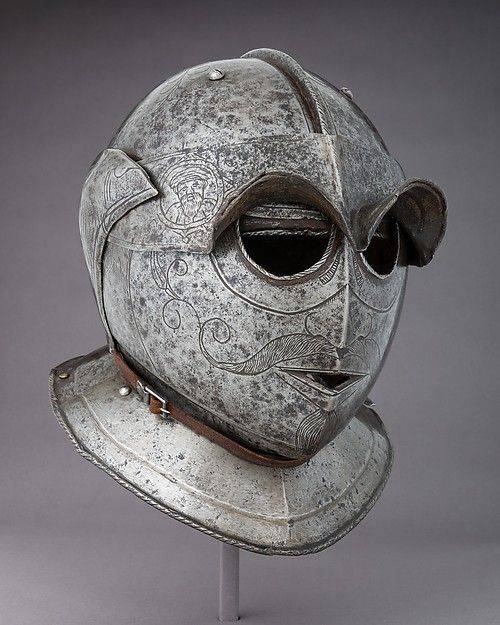
Siege helmet covered with engraved ornaments. Italy, approx. 1625. Metropolitan Museum, New York.
In this regard, such English historians as David Edge and John Padok came to the conclusion that by the middle of the 15th century, two centers (and two different schools) were formed, producing all-metal armor: the first in northern Italy, in Milan, and the second - in the north of Germany, in Augsburg. Of course, there were many different local productions that focused on one or the other of these centers, and copied popular samples.
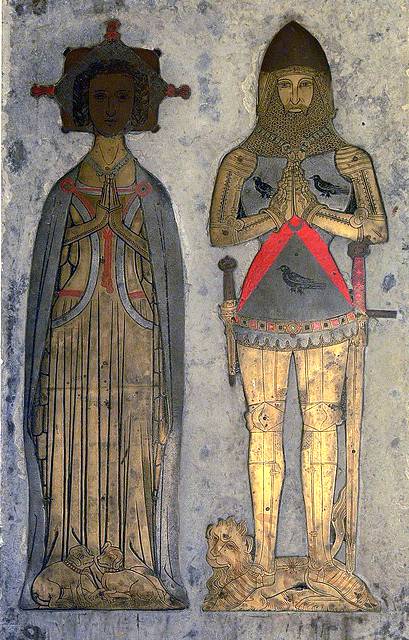
Tombstone brass plate (breaststroke) by William Bagot and his wife Margaret. Church of sv. John, Baginton, Warwickshire, 1407. As you can see, on the deceased there is typically “transitional” knightly armor - there are plate details, but the torso closes the short heraldic Jupon, so you cannot see what is under it. But the chainmail barmitsa on the helmet is perfectly visible.
Such a famous British historian, as D. Nicole, in his work “The French Army in the Hundred Years War” cited an excerpt from an essay by the unknown author of the book “Military Costumes of the French in 1446”, which gives the following description of the equipment of those years. “First of all ... in preparation for the battle, they wore full white armor. In short, they consisted of a cuirass, shoulder pads, large braces, armor for the legs, military gauntlets, a salad with a visor and a small chin that covered only the chin. Each warrior was armed with a spear and a long light sword, a sharp dagger suspended to the left of the saddle, and a mace. ”
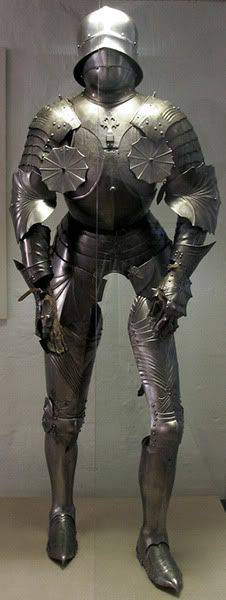
Typical knight in gothic armor. 1480 - 1490 Ingoldstadt, Germany, Bavarian Military Museum.
It's funny, but in England at that time they didn’t feel their inferiority at all because they didn’t do their armor. The lack of production, we can say, was simply noticed, since both the most notable of the British lords and the gentry — the gentry then ordered armor on the continent. For example, the effect of Sir Richard Byuchamp, Earl Warwick, referring to 1453, shows him in the Italian "armor" of the most "latest model".

Chainmail from flat riveted rings.

Chainmail from flat, perforated and round riveted rings.
Beginning with the early Middle Ages, among the gunsmiths, armourists occupied a very important place. Although the chain armor was still worn by Roman legionnaires, the production of this type of armor in Western Europe, in fact, was created anew. The rings for chain mail at that time were made of forged, flattened wire, the rings of which were joined by cold riveting. In the later chain mails of the 14th and 15th centuries, one of the rings was already soldered, and the other was riveted, and it was for this reason that they were distinguished. Later all the rings just riveted. The historian Vendalen Beheim, for example, indicates that the drawn wire was not even used for making rings even in the 16th century. Well, in the 1570's, the chain mail has finally ceased to be used, and this once highly respected craft has disappeared forever. That is, it did not disappear at all, but the former mass character was gone forever.

Ring cloth of round riveted rings with a diameter of 7 mm.

Chainmail from flat riveted blued rings.
Since we are talking about the "colors" of armor, it should be noted that the chain mail gleamed "like ice", that is, they also had the appearance of "white metal", but not everywhere. In the East, it was customary to weave copper rings in them and thus create intricate patterns in chain mail. It is difficult to say how much it reduced their strength, but it was so, and such chain mail reached our time and were also known in Russia, where the “Pansyrs of chain mail with a copper valance” were mentioned. Known were also chain mail of blued rings.
And it was just the abandonment of the chain mail that led to the search for more advanced forms of protective armor, which came in the first half of the 15th century. It all began again with the improvement of protection for the head, that is, with helmets. A helmet appeared, called the salle, sallet or salad (which is more usual for Russian-language spelling), which was especially popular with the gunsmiths of Germany.
Sarcophagus with the grave effect of the Spanish knight Don Alvaro de Cabrero the Younger from the church of Santa Maria de Belpuig de las Avellanas in Lleida, Catalonia. The knight's neck is protected by a stand-up metal collar-burner, and his legs are already protected by armor. It is also obvious that under his clothes metal plates are riveted, which give out the heads of rivets. Unfortunately, he doesn’t have a helmet on his head, and how he looked is unknown. Mid 14th century
D. Edge and D. Paddock called the year - 1407, when it appeared, and not just anywhere, but in Italy, where it was called Selata. And only then through France, Burgundy, did he get to 1420 from Germany, then to England, and after that he became very popular in Europe everywhere.
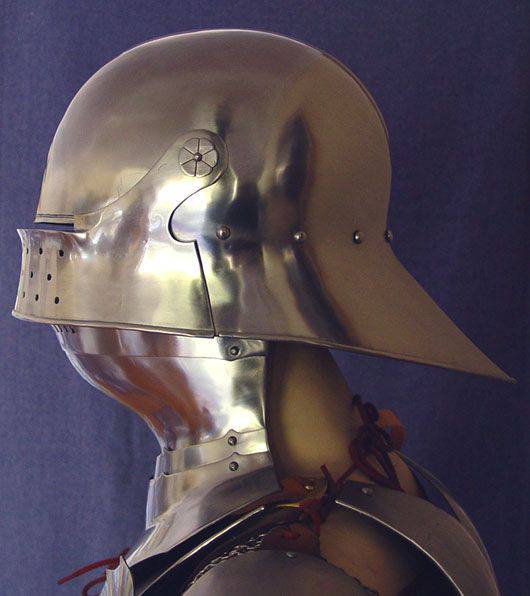
Typical German sallet: weight 1950 g .; the weight of the precursor of bevor 850 g. Both items are novelties: the price of sallet is $ 1550, the bevore is $ 680.
Germanic helmets had a nazatylnik in the shape of an elongated tail; among the French and Italians, they more resembled the bell. And again, they both had no decorations. Their main "decoration" was the polished steel itself. Only about 1490 of the year did the so-called “black fat” become known, with foreheader, which came forward at an acute angle. But they called him black because of their color (for some reason they were painted black or was it blackened?), Although such helmets were often covered with colored fabrics. As a "color helmet" visually combined with brilliant "white armor", the story is silent. But "mods" who wore "such" existed. Moreover, horseback warriors of ignoble origin used helmets of this type, for example, horse archers used by the French, and not too rich and noble "knights of one shield", and even ... the infantrymen-infantrymen.
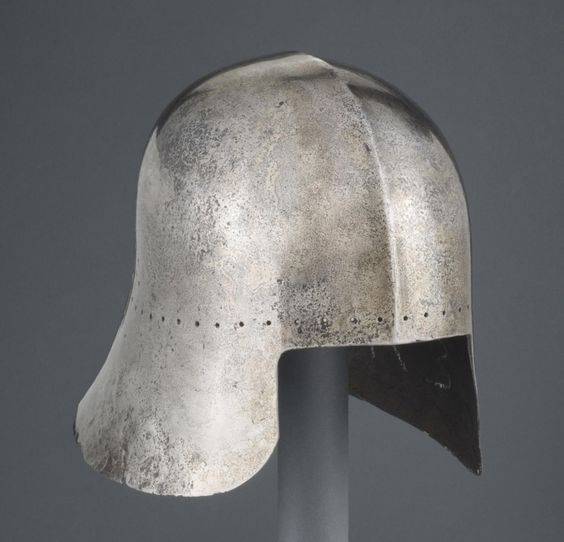
The simplest Italian salle, 1450 - 1470's. Philadelphia Museum of Art, Philadelphia, USA.
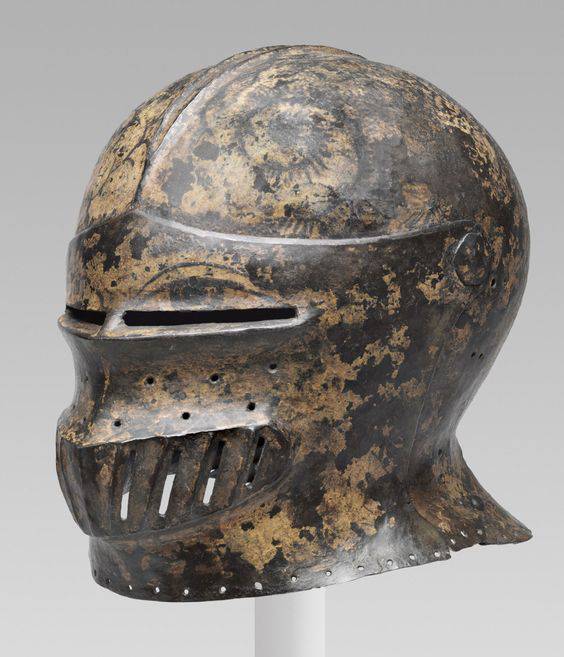
This is exactly the “black sallet”, and the knight’s, with a rising visor. Germany or Austria, 1505 - 1510 Philadelphia Museum of Art, Philadelphia, USA.
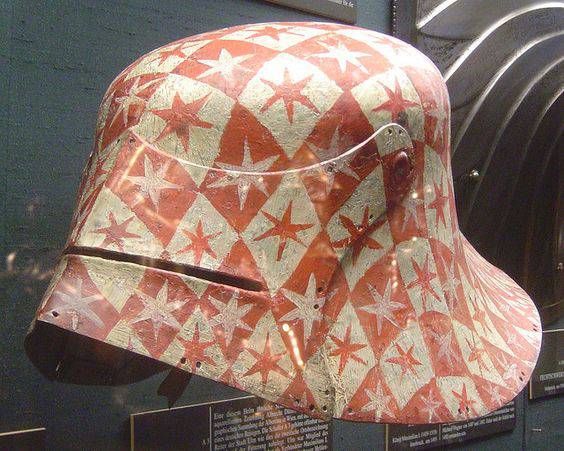
Another black sallet, about. 1490 - 1500 The so-called "salm from Ulm", and not at all black, and incomprehensible as combined with "white armor." South Germany, Historical Museum, Vienna.
The story of a helmet bascinet or “bundhugel” (“dog's helmet”) is very funny. At first it was just a cheap cap comforter, similar to a tophelm bucket. Then he began to stretch upward and at the same time sink to the neck and temples.
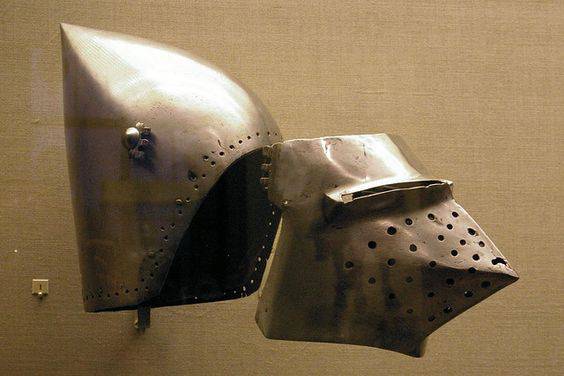
Bascinet and visor to him, possibly France, approx. 1390 - 1400 Philadelphia Museum of Art, Philadelphia, USA.
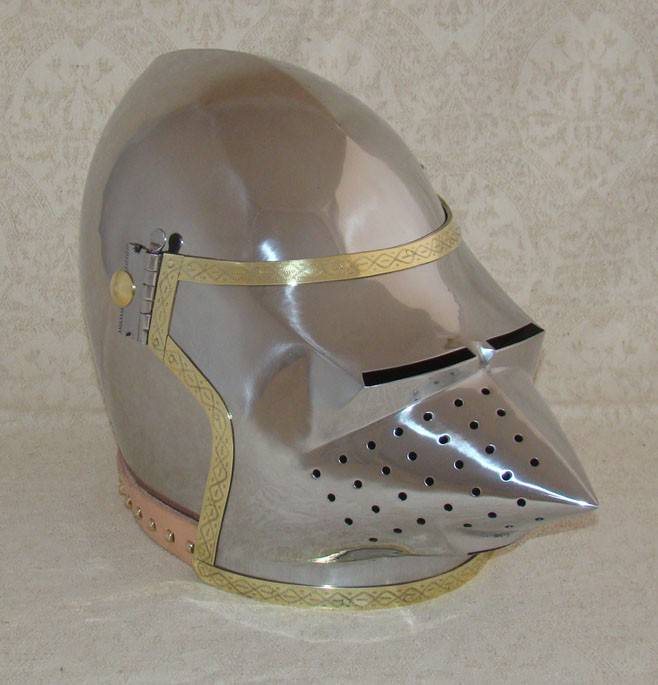
The bascinet of the 14th century, replica. 1.6 mm steel. Royal Arsenal in Leeds, England.
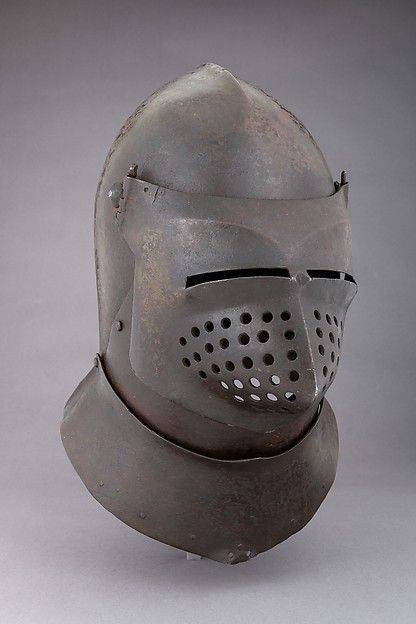
For comparison, the Germanic bascinet from the Metropolitan Museum in New York. Everything is simple, functional and no decorations!
It remained to attach to him the visor, which in the end was done in the same XIV century. And the visitor not only rose, but was removed from it entirely. For its characteristic shape, the helmet was called the “dog muzzle”, primarily in Germany. It was very functional and came in a period when the armor was still not decorated. Therefore, its main decoration was polished, although, according to Henrik Senkevich’s novel “The Crusaders”, the German knights were fastened to these helmets by magnificent peacock-sultans of feathers.
A shot from the film "Crusaders". As you can see, helmets on knights look like real ones, but otherwise this is pure fiction! Poles were too lazy to sew "caps" and to knit also chain mail headdresses and barmitsa. And besides, plastic is immediately visible! Breastplates and helmets - typical dyed polystyrene!
Here in the 2005 movie of the year “Joan of Arc” directed by Luc Besson, the armor is basically the same as it should be, and the helmets are worn on the head with balaclava.
By the way, in this 1960 movie of the year you can see that the armor of knights is reproduced outwardly and reliably, but very much too primitive. And the most amazing thing is that the helmets of the knights in it are worn on the head without a chainmail hood and a barmitsa loose on their shoulders. But, judging by the effigy, the latter could even be worn with solid-forged "white armor" just in the 1410 year, and ... you can imagine how vulnerable such protection was for the "all-metal knight." That is why, by the way, the same bascinet soon turned into a “big bascinet”, which differed from the usual only in that when with a “dog muzzle”, instead of a chainmail mailweaver, our necklace of metal plates was attached, which was attached with straps to the cuirass!
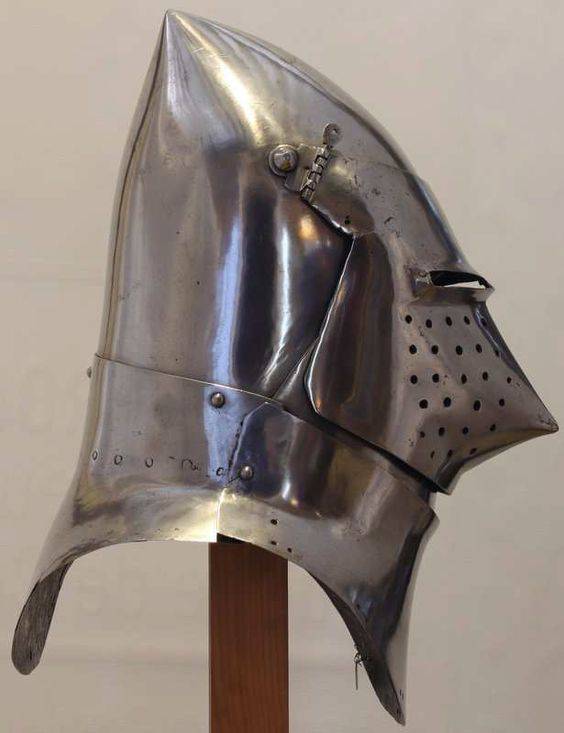
"Big bascinet" from the Army Museum in Paris. OK. 1400 - 1420
The most perfect in this regard was the helmet of the arm, which also appeared around the same time, and which had a rising visor and ... a very complex system of connecting all its parts into a single whole. But these helmets had already been decorated with embossing and often resembled anything, not only the helmet itself, but the form in this case has only an indirect relation to the “color”.
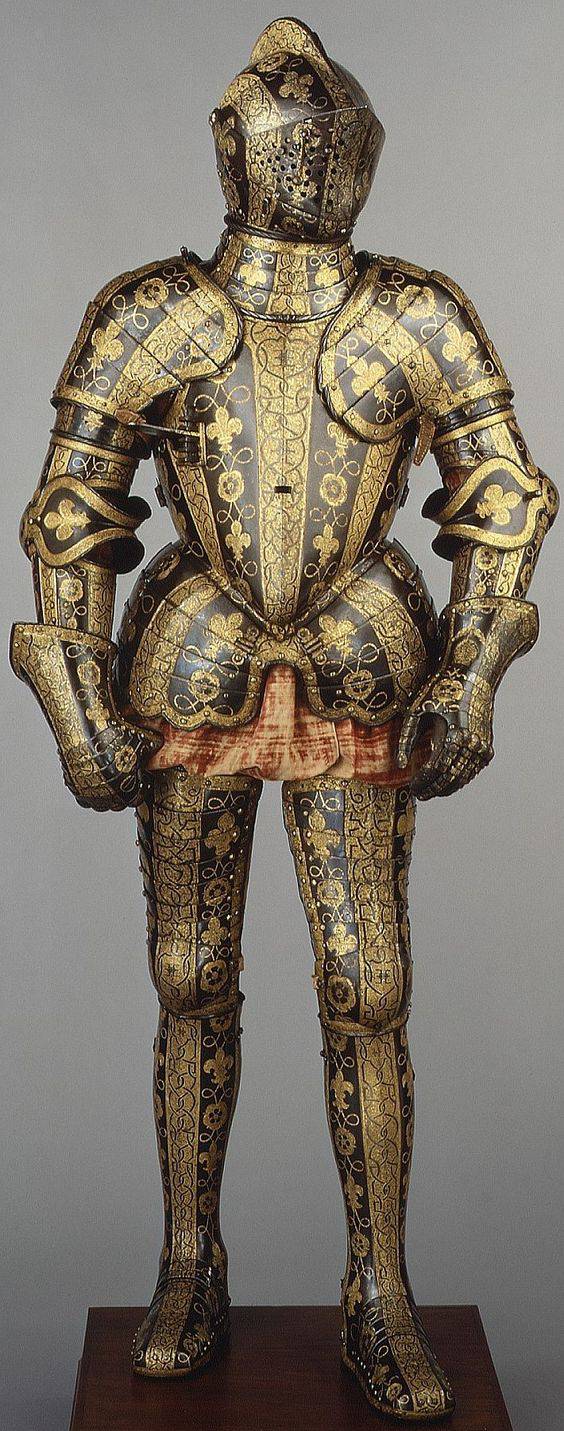
Exceptionally lush armor of George Clifford, the third Earl of Cumberland (1558 - 1605). Here you can’t even name all the finishing technologies! Metropolitan Museum, New York.
Another thing is that in very purely metal armor it was not fashionable to walk very quickly and, apparently, even indecently - the situation repeated with respect to all-12th-century armor that wrapped the figure of a warrior like a glove. But now both armor and, in particular, helmets began to be covered with expensive fabrics, often embroidered with gold threads and even decorated with precious stones.
(To be continued)
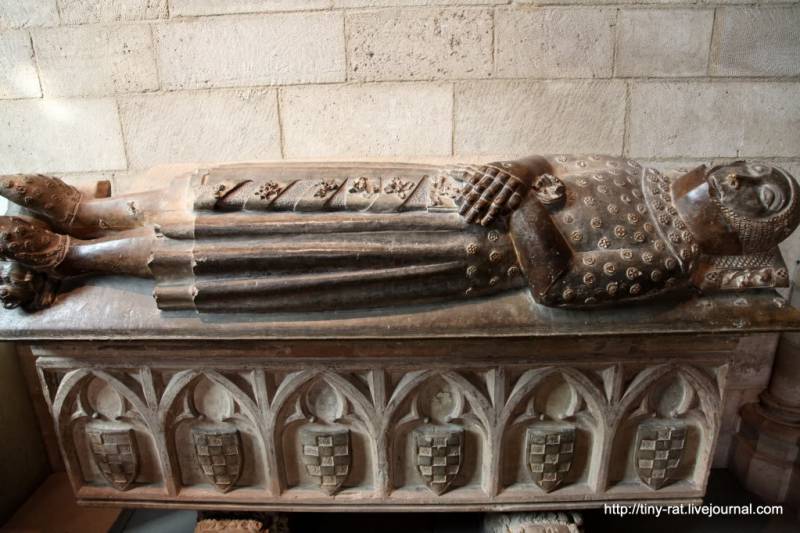
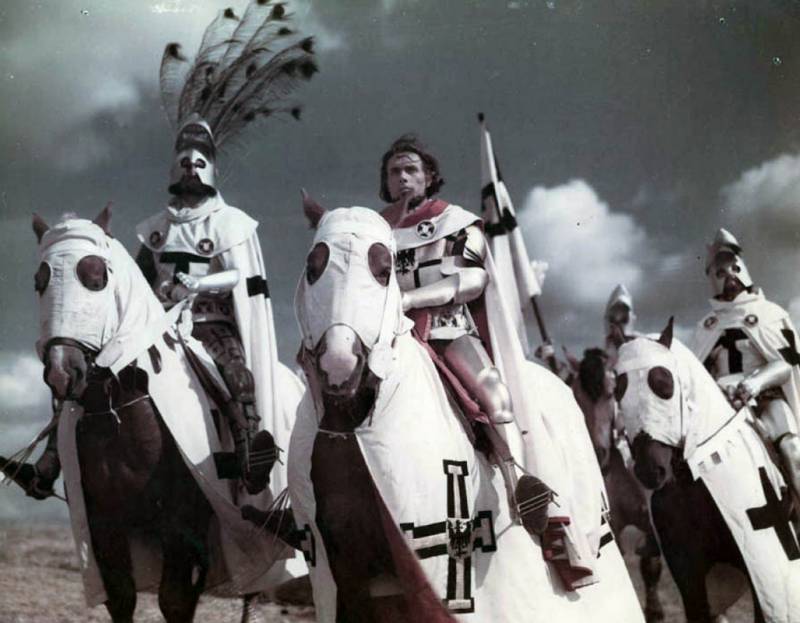
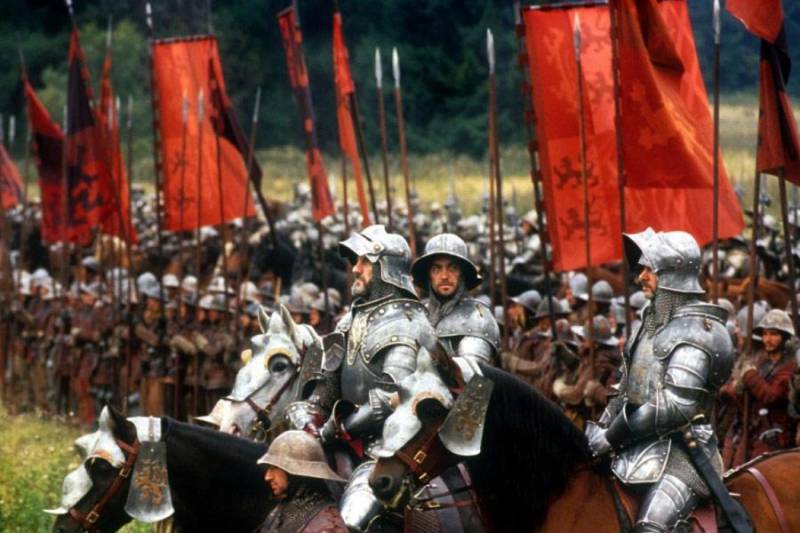
Information